Page snapshot: Introduction to the geologic history of the northeastern United States from the Precambrian to the Quaternary Period.
Topics covered on this page: Grenville Orogeny (Precambrian); Breakup of Rodinia and Origin of the Iapetus Ocean (Precambrian); Taconic Orogeny (Cambrian and Ordovician); Exotic Terranes (Ordovician to Devonian); Acadian Orogeny (Silurian to Mississippian); Alleghanian Orogeny (Devonian to Permian); Breakup of Pangaea (Triassic and Jurassic); Formation of the Coastal Plain (Cretaceous to Neogene); Ice Age (Quaternary); Resources.
Credits: Most of the content of this page is derived from The Teacher-Friendly Guide to the Geology of the Northeastern U.S. (published in 2000 by the Paleontological Research Institution; currently out of print) by Jane E. Ansley, with substantial updates by Andrielle Swaby and Jonathan R. Hendricks.
Updates: Page lasted updated September 28, 2022.
Image above: Geologic map of the northeastern United States, derived from the United States Geological Survey "Tapestry of Time" by Kate E. Barton, David G. Howell, and José F. Vigil (public domain).
The Big Picture
The geologic history of the northeastern United States is a story of active mountain building and the quieter processes of weathering, erosion, and deposition of sediments. The Northeast is at the edge of a continent (North America), but in the middle of a plate (the North American plate), which extends from the mid-Atlantic ridge to the West Coast. Today this part of North America is tectonically inactive, but this was not always the case. Millions of years ago, the Northeast was the site of multiple continent-continent collisions and the rifting of supercontinents. Repeated episodes of mountain building, sea level changes, and the erosion and deposition of sediment shaped the Northeast as we know it today.
In the following discussion, the northeastern U.S. states are divided into five different physiographic provinces or regions: the Central Lowland (1), the Inland Basin (2), the Appalachians and Piedmont (3), the Coastal Plain (4), and New England (5). Each of these regions has a different geological history and thus varies in terms of rocks, fossils, topography, mineral resources, soils, and other geological features.
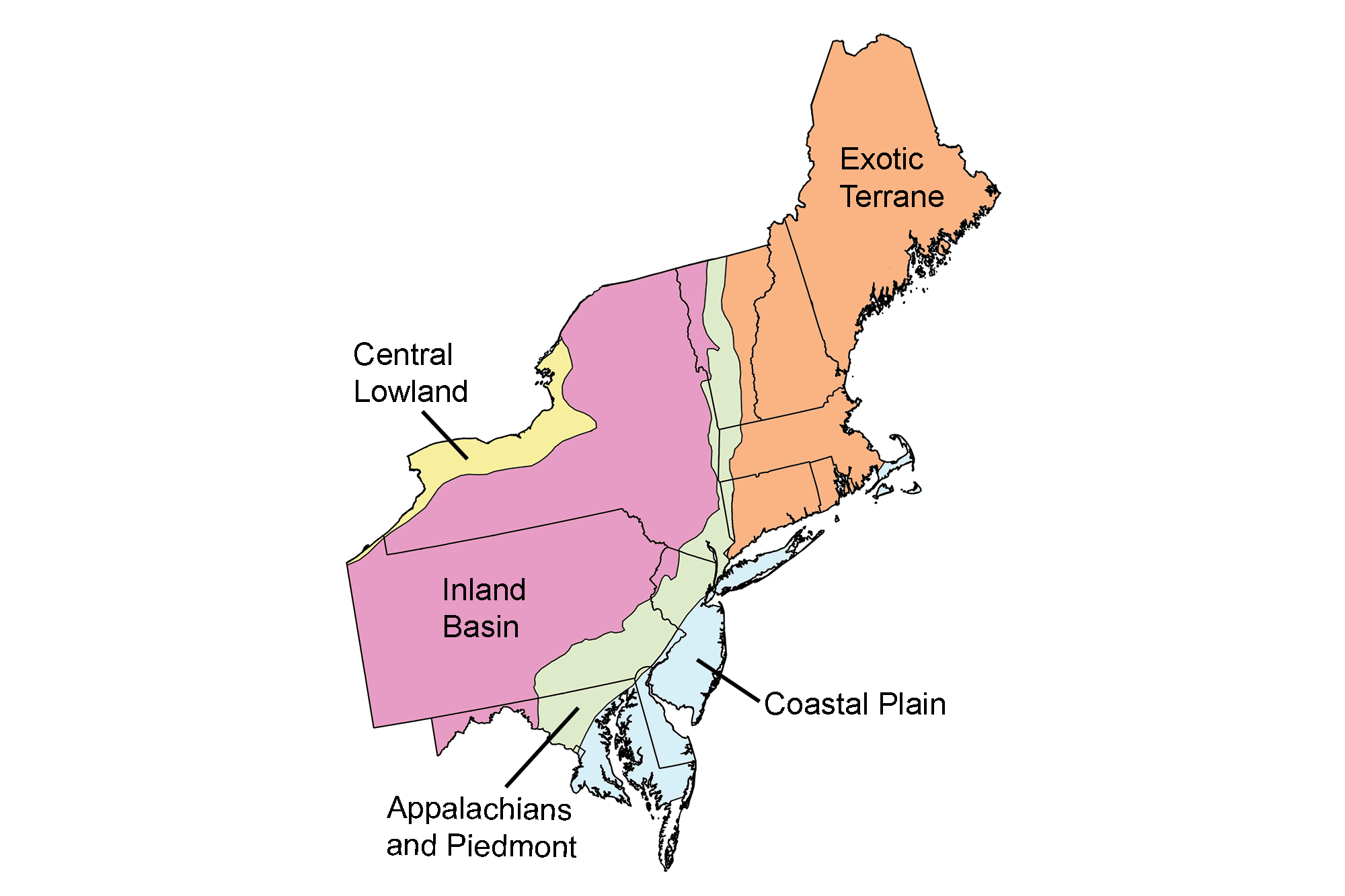
Major physiographic regions of the northeastern United States.
Precambrian
Mountain Building Part I: The Grenville Mountains
The Earth is estimated to be approximately 4.6 billion years old—an age obtained by dating meteorites. Rocks dating to around four billion years old are found on almost every continent, but they are not found at the Earth’s surface anywhere in the Northeast. The oldest rocks known on Earth are 4.3-billion-year-old rocks found along the eastern shore of Hudson Bay in northern Quebec. These are part of the Canadian Shield, the ancient core of the North American continental landmass, which has experienced very little tectonic activity (faulting and folding) for millions of years. Shields, or cratons, are the stable cores of all continents and are often covered by layers of younger sediments. They formed and grew during pulses of magmatic activity, as bodies of molten rock deep in the Earth’s crust contributed to form new crust. The oldest rocks exposed in the Northeast are Precambrian gneisses, exemplified by the Baltimore Gneiss in Patapsco State Park, Maryland and the Fordham Gneiss in the Bronx of New York City. These rocks, dated at 1.1 billion years of age, were metamorphosed during a major period of mountain building called the Grenville Orogeny.
The shape and position of North America has changed dramatically over the last billion years, and geologic processes continue these changes today. Compression from colliding plates, tension from plates pulling apart, the addition of land to North America, weathering, and erosion have all combined to slowly sculpt the form of the continent. The Grenville Orogeny was one of several Precambrian continental collisions that led to the assembly of the supercontinent Rodinia between about 1.4 billion and 900 million years ago.
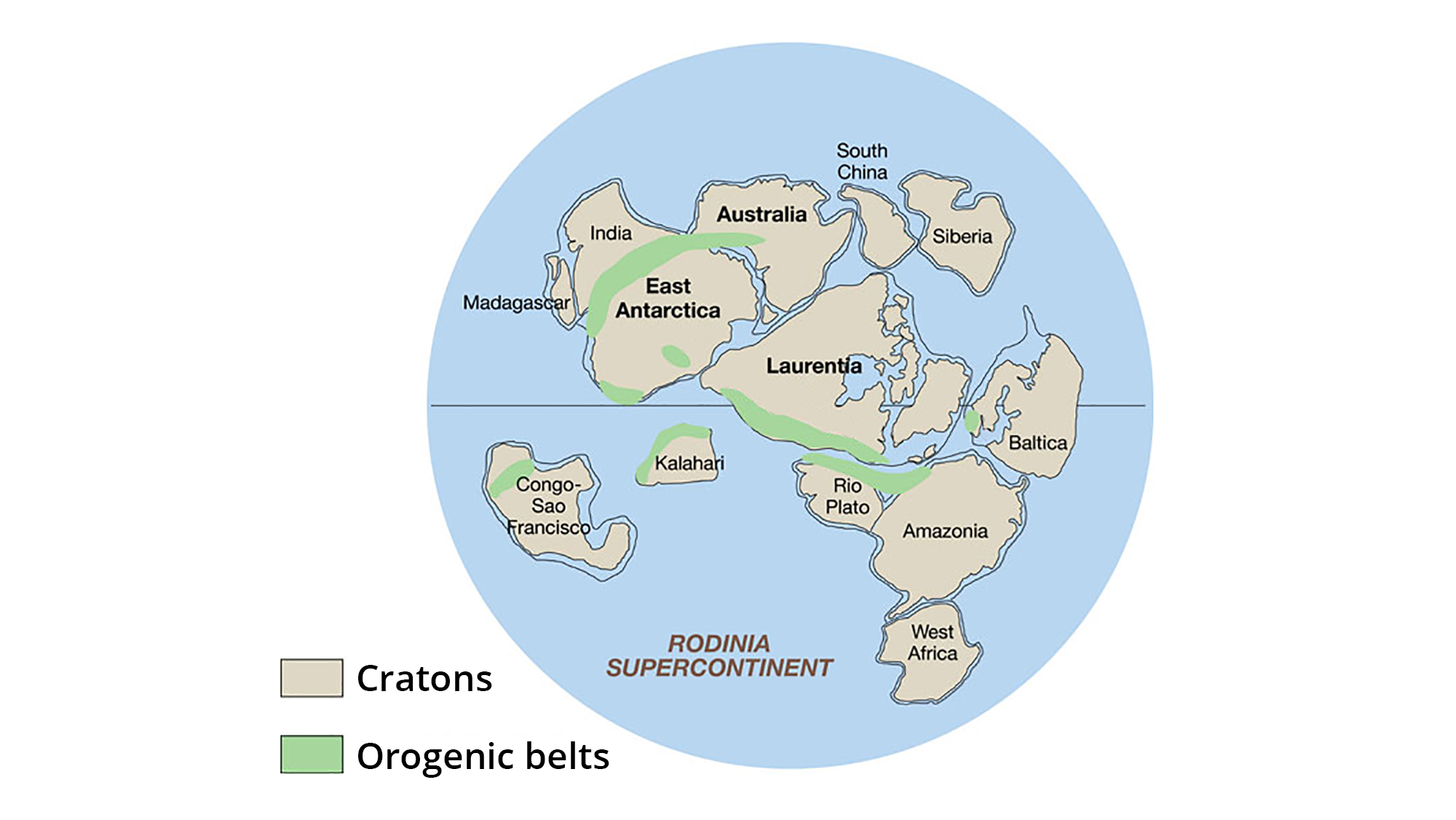
The supercontinent Rodinia, around 1.1 billion years ago. Laurentia represents proto-North America. Image adapted from original created by John Goodge for the United States Geological Survey (public domain).
During the orogeny, a number of smaller continental blocks and offshore islands were added to the much older core of the proto-North American continent, called Laurentia. Sediment that eroded from the Grenville Mountains was transported by rivers and streams across the ancient continental margins and into the adjacent oceans. Sediment deposited in the ocean waters on Laurentia’s eastern margin composes a series of rocks that geologists call the Grenville Series (or the "Grenville Belt" in older literature). The name Grenville comes from a unit of metamorphosed sedimentary rocks located in Quebec, Canada. It is used to refer both to an event (the Grenville Orogeny), and to rocks that formed as a result of that event (Grenville rocks).
The ancient Grenville rocks tell a story of repeated collision-related mountain building on North America's east coast. Intense heat and pressure associated with these continent-continent collisions produced molten rock that was injected into the crust, metamorphosing sediments that had eroded from the craton and thrusting them up onto the side of the continent. The collisions created a tall (perhaps Himalaya-scale) mountain range, the Grenville Mountains, which stretched from Canada to Mexico. Orogenic compression folded (and even completely overturned) the metamorphosed sedimentary rocks and igneous intrusions of these mountains, forming the basement rock of today's Appalachians. At this point in geologic time, very little existed of the Northeast as we now know it. All of New England east of the Berkshires and Green Mountains was not yet part of North America, and would not even be assembled for several million more years. The sediments that eventually solidified into the rocks of the present Coastal Plain had not yet been deposited.

Grenville mountain building during the Precambrian. Images modified from original by J. Houghton first published in The Teacher-Friendly Guide to the Geology of the Northeastern U.S. by Jane Ansley (published by the Paleontological Research Institution) (CC BY-NC-SA 4.0 license).
Weathering and erosion are constants throughout the history of time. Rocks are constantly worn down and broken apart into finer and finer grains by wind, rivers, wave action, freezing and thawing, and chemical breakdown. Over millions of years, weathering and erosion can reduce a mighty mountain range to low rolling hills. Just as mountains continually erode today, the Grenville Mountains eroded for the next few hundred million years after their formation. By 600 million years ago, weathering had worn away the mountains, leaving exposed only their innermost cores. In most areas, ancient Grenville rocks are now covered by thousands of meters of younger rocks; however, exposures are found where overlying rocks have been worn away by erosion and the scraping action of glaciers. In the Northeast, weathering left the ancient mountain cores exposed in such places as the Adirondacks (learn more here), the Hudson and Jersey Highlands, Manhattan and Westchester in New York, the Green Mountains of Vermont, the Reading Prong of Pennsylvania, and the Berkshire Hills of Massachusetts

Exposures of Grenville age rocks are found up and down the East Coast and Canada. Image modified from original by J. Houghton first published in The Teacher-Friendly Guide to the Geology of the Northeastern U.S. by Jane Ansley (published by the Paleontological Research Institution) (CC BY-NC-SA 4.0 license).
The Grenville rocks are covered in many areas by younger rocks; however, exposures are found where overlying rocks have been worn away by erosion and the scraping action of glaciers. In the Northeast, the Grenville rocks are exposed in the Adirondacks, the Hudson and Jersey Highlands, Manhattan and Westchester in New York, the Green Mountains of Vermont, the Reading Prong of Pennsylvania, and the Berkshire Hills of Massachusetts.
During the erosion of the Grenville Mountains in the late Precambrian, the geography of the world looked nothing like today. North America was positioned on its side across the Equator, with today’s east coast facing south. Sediments were eroding from the Grenville Mountains on either side. The ocean breaking on the shores of the east coast was known as the Iapetus or Proto-Atlantic Ocean. Given the equatorial position of the continent, the Northeast was experiencing a warm climate. This is the earliest geography of the Northeast region that can be reconstructed. At this point in geologic time, all of New England east of the Berkshires and Green Mountains was not yet part of North America. New England was not assembled for several million more years.
Ancient Rifting: The First Breakup
Following Rodinia's assembly around 700 million years ago, Laurentia began to break away from the rest of the supercontinent as a result of tensional forces beneath the continental crust. A series of cracks known as rifts formed throughout the landmass. During this time, the Earth experienced the most extreme episodes of glaciation in its history, with ice sheets spreading all the way into tropical latitudes.
Around 565 million years ago, the continents split apart completely at a major rift that became floored by oceanic (basaltic) crust and flooded by ocean water. Geologists call this ocean the Iapetus Ocean (or proto-Atlantic), because the modern Atlantic Ocean opened up in a similar way and position relative to modern-day North America and Europe. In Greek mythology, Iapetus was the son of Uranus, the sky god, and Gaia, the mother of Earth and all the other gods. Geologists use the name Iapetus for the ocean that formed to the south of the ancient continent Laurentia during the Paleozoic. In many textbooks, Iapetus refers to the entire ocean between Laurentia and Gondwana. Some geologists use it in a narrower sense, referring only to the stretch of ocean between Laurentia and the Taconic island arcs prior to the Taconic Orogeny.
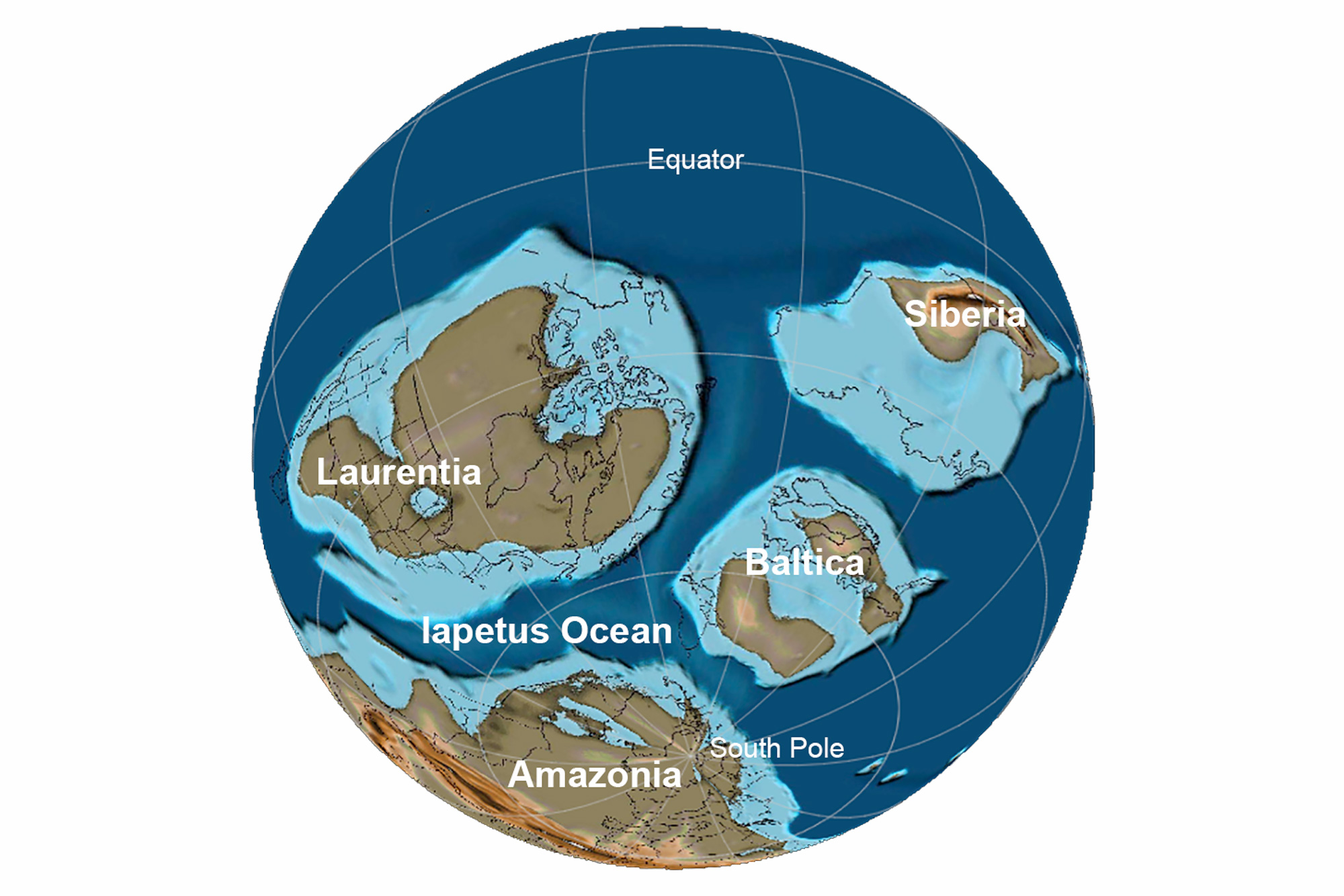
Earth at the end of the Precambrian, 565 million years ago. Laurentia is the name given to "proto-North America"; Baltica consists of modern northern European countries; Amazonia, which was part of Gondwana, includes much of modern Brazil. All of these continents were positioned south of the equator 565 million years ago. Reconstruction created using basemap from the PALEOMAP PaleoAtlas for GPlates and the PaleoData Plotter Program, PALEOMAP Project by C. R. Scotese (2016); map annotations by Jonathan R. Hendricks for PRI's Earth@Home project (CC BY-NC-SA 4.0 license).
A rift occurs when tectonic plates split and the pieces move away from each other. The rift forms a deep valley that is eventually invaded by sea water. Magma rises up into the gap, cooling to produce new oceanic crust along the margins of the separating plates. The resulting action is similar to two conveyor belts moving in opposite directions. A failed rift occurs when the existing crust is stretched thin and magma begins to well up, but the plate is never completely broken.
Not all of Rodinia's rifts broke completely across the continent. Instead, some of them remained as elongate rift basins within the continental crust, formed when pieces ("blocks") of crust slid downward along faults. These basins filled with sediment eroded from land to the west, along with intrusions of basaltic lava that welled up through cracks in the basins. One such buried basin is the Rome Trough, which stretches from Kentucky and West Virginia up through Pennsylvania. The rift that became the Iapetus Ocean is partially filled by ancient sandstone, which is visible in the Potsdam Sandstone of New York and Vermont. This rifting formed an irregular margin along the edge of Laurentia, consisting of a series of projections or promontories (that are found in what is now New York, Alabama, and the St. Lawrence region of Quebec), and embayments (Pennsylvania, Newfoundland, and Tennessee). The promontories received little or no sediment during the Precambrian, but the embayments accumulated thick piles of sediment from the eroding continent.
During the late Precambrian and early Cambrian, Laurentia was positioned near the equator, and the Northeast was rotated roughly 90° clockwise relative to its current position—today's east coast faced south (see image above). The lack of tectonic activity along the continent's coastline made it a passive margin, similar to the Atlantic and Gulf coasts of the US today. The continental margin of North America was broad and flat, and as the young Iapetus Ocean widened, global sea levels also rose, flooding much of Laurentia's interior (and that of other continents) with seawater. These relatively shallow epicontinental seas were sites of widespread deposition of carbonate sediment derived from the abundant organisms living there; these sediments formed limestones, including those seen today in Maryland and Pennsylvania. Sediments continued to erode from either side of the Grenville Mountains into the deeper Iapetus Ocean to the south (presently east) and the shallow epicontinental sea to the north (presently west).

As the Grenville Mountains gradually eroded over millions of years, sediments were deposited on either side of the range and become interlayered with carbonate rocks that formed in shallow parts of shallow inland seas, as well as along North America's passive continental margin. Image modified from original by J. Houghton first published in The Teacher-Friendly Guide to the Geology of the Northeastern U.S. by Jane Ansley (published by the Paleontological Research Institution) (CC BY-NC-SA 4.0 license).
Cambrian and Ordovician
Northeast Mountain Building, Part 2: The Taconic Mountains
Around 500 million years ago, the Iapetus Ocean stopped widening and the continents began to move back toward each other. As the Iapetus Ocean narrowed, the plate carrying Baltica (proto-Europe) approached the North American plate from the southeast.
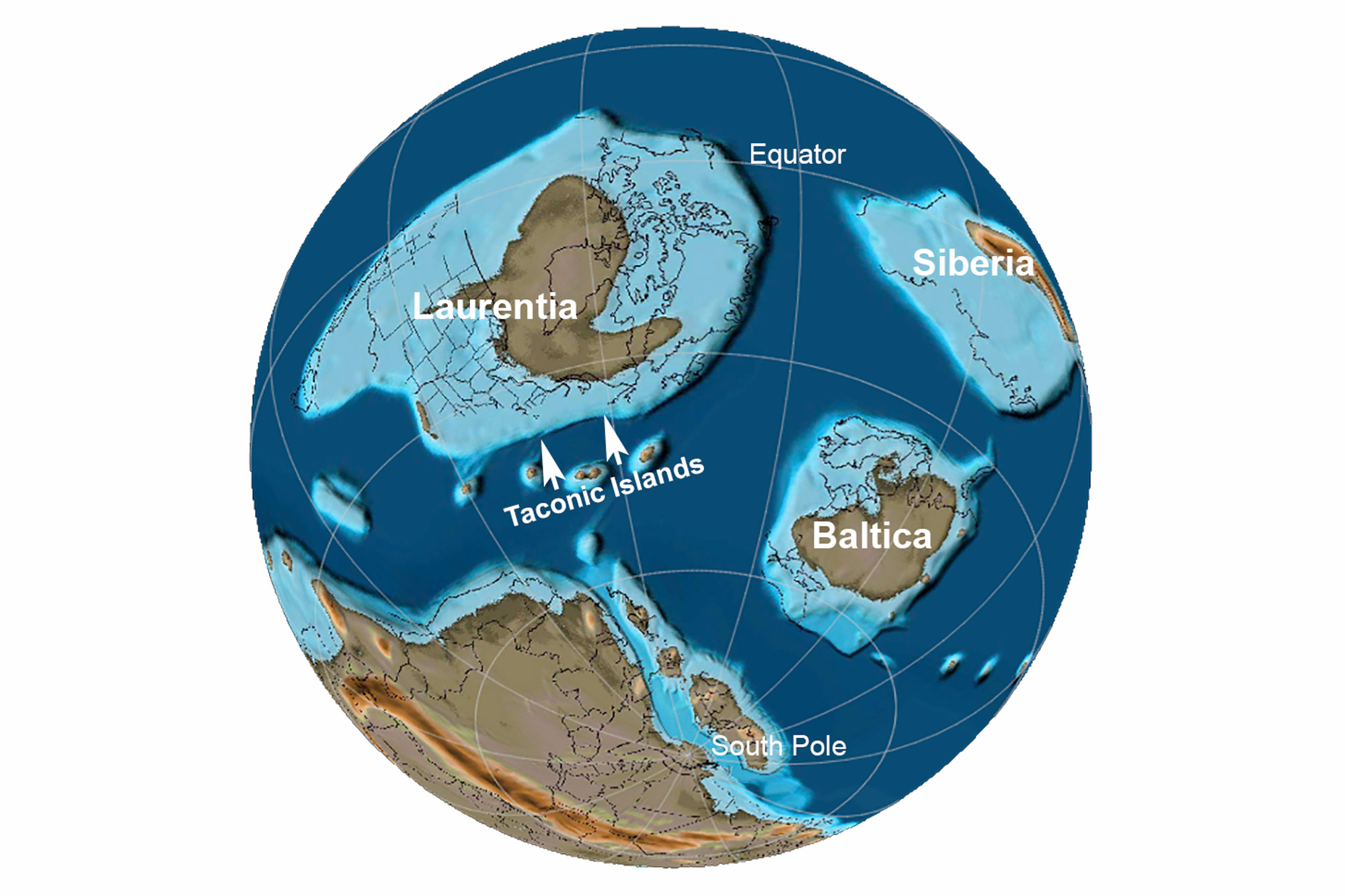
Earth 485 million years ago, at the beginning of the Ordovician Period. Laurentia is the name given to "proto-North America"; Baltica consists of modern northern European countries. Reconstruction created using basemap from the PALEOMAP PaleoAtlas for GPlates and the PaleoData Plotter Program, PALEOMAP Project by C. R. Scotese (2016); map annotations by Jonathan R. Hendricks for PRI's Earth@Home project (CC BY-NC-SA 4.0 license).
Though Baltica did not collide with North America until millions of years later, the convergence of the two plates created a whole new look for the eastern margin of North America. As the continents approached one another, the oceanic crust in the middle was forced under the Baltica plate, forming a subduction zone. The friction and melting of the crust from the intense pressure of the colliding plates created a volcanic island arc, called the Taconic islands, which eventually collided with the margin of North America and accreted to the continent. The subduction of the oceanic plate beneath North America is recorded by a series of rocks called ophiolites. These rocks, which include deep-sea sediments deposited on the oceanic crust, the oceanic crust itself, and rock from the upper mantle, were scraped off the descending plate and attached to the continental crust.

The formation of an ophiolite at a subduction zone. Image modified from original by J. Houghton first published in The Teacher-Friendly Guide to the Geology of the Northeastern U.S. by Jane Ansley (published by the Paleontological Research Institution) (CC BY-NC-SA 4.0 license).
This set of collisions caused a new episode of mountain building between 490 and 460 million years ago, known as the Taconic Orogeny.
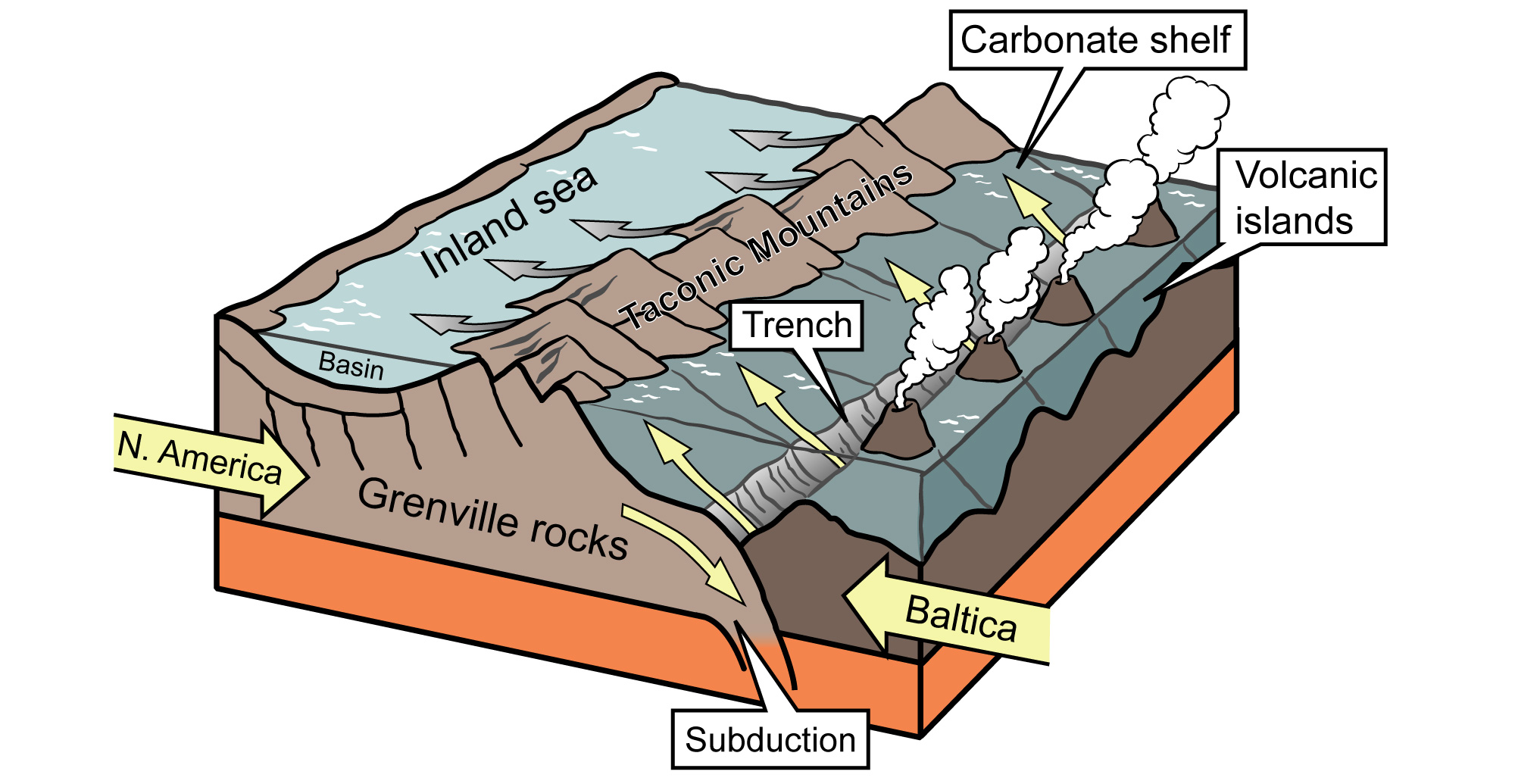
Volcanic islands formed where the plates were forced together as the Iapetus Ocean closed. The compression crumpled the crust to form the Taconic Mountains and a shallow inland sea farther to the west. Image modified from original by J. Houghton first published in The Teacher-Friendly Guide to the Geology of the Northeastern U.S. by Jane Ansley (published by the Paleontological Research Institution) (CC BY-NC-SA 4.0 license).
The pressure of these collisions was so great that large slabs of crust broke free and were pushed up and over the edge of the continent in a process called thrust faulting. This combination of folding, thrusting, uplift, and intrusion of melted rock occurred along the entire margin of North America.
Large chunks of rock such as the Taconic islands, which originate in one place and are eventually added to a continent, are called terranes (or sometimes "exotic" terranes to emphasize their distant origin). Some terranes are little more than chains of volcanoes; others are small blocks of continental crust that are sometimes called microcontinents. Addition (or accretion) of terranes is one of the major ways in which continents grow in size, as they are pressed against the edge of the continent in a process sometimes known as "docking." After accretion, the boundaries between adjacent terranes are marked by major faults or fault zones. In the Northeast, the islands that collided with North America during the Taconic Orogeny are today known as the Taconic Mountains. These volcanic remnants may be found in a thin band of rocks that extends from northernmost Vermont through northern New Hampshire, and up the western and northernmost portion of Maine.
The compression induced by the collision of the Iapetus and Taconic rocks with North America also depressed (downwarped) the crust to the west of the Taconic Mountains, creating the Appalachian Basin. This basin, actually a connected set of basins that stretched from New York to Tennessee and formed in stages between the Ordovician and Carboniferous, was flooded by a broad, shallow inland sea and filled with sediment eroded from the Taconic Mountains. The inland ocean, which spread across much of New York, Pennsylvania, and western Maryland, was similar to the modern Persian Gulf, at some points becoming very salty because of its shallow water, high rate of evaporation, and poor circulation.
Geologically "quiet" times in the Northeast, between the rise of great mountains and the crushing crusts of colliding plates, were marked by erosion of the highlands and very little plate movement and compression. The Taconic Orogeny ended by the late Ordovician, and for many millions of years afterward, the Northeast experienced a time during which erosion from the Taconic highlands and deposition in the inland sea were the main geological events. Huge thicknesses of sedimentary rocks accumulated in and on the margins of the inland sea during the late Ordovician. As sediment weathered from the western side of the Taconic Mountains, deltas—wedge-shaped deposits formed when eroded sediment is transported from the mountains and fans out across lower elevations—spread along the shoreline. A wedge of sediments spreading away from the Taconics through New York and Pennsylvania formed the Queenston Delta. (The Mississippi Delta is a modern delta that dumps sediment from the Mississippi River into the Gulf of Mexico.)

The Queenston Delta formed as sediments eroded from the Taconic Highlands and were transported downward by streams, forming characteristic wedge-shaped delta deposits. Image modified from original by J. Houghton first published in The Teacher-Friendly Guide to the Geology of the Northeastern U.S. by Jane Ansley (published by the Paleontological Research Institution) (CC BY-NC-SA 4.0 license).
Some of the delta sediments settled in the shallow inland sea, gradually filling the basin. Sediments were also eroded and deposited east of the Taconics into the trench formed where the tectonic plates converged.
Eventually, the Taconic Mountains eroded away to only their inner core, as had the Grenville Mountains previously. The rounded Berkshire Mountains of western Massachusetts are part of the Taconics’ ancient roots. In addition, further compression of the crust during the Taconic and later Acadian mountain-building events thrust huge slabs of the ancestral Taconic Mountains (known as the Taconic Klippe) westward from Vermont and Massachusetts into eastern New York. This caused older, more resistant rocks from the Taconics to end up on top of younger sedimentary rocks from the inland ocean, overturning the stratigraphic sequence in a process called telescoping. The resistant blocks from the ancestral Taconic Mountains weathered much more slowly than the surrounding rocks did, eventually becoming the Taconic Mountains we see today.
Ordovician to Devonian
Exotic Terranes: The Making of New England
Before the Ordovician period, North America was missing most of what we know of today as New England. Formed over millions of years, New England was slowly pieced together by the addition of several tiny strips of land to the proto-North American continent. These strips of land, called exotic terranes, are small landmasses that originated from somewhere other than North America and were tacked on to the continent as plates converged. Due to their distant origin, exotic terranes have distinctly different geologic characteristics than the surrounding rocks do.
Over several million years, two exotic terranes were added to proto-North America: the Iapetus Terrane and the Avalon microcontinent.
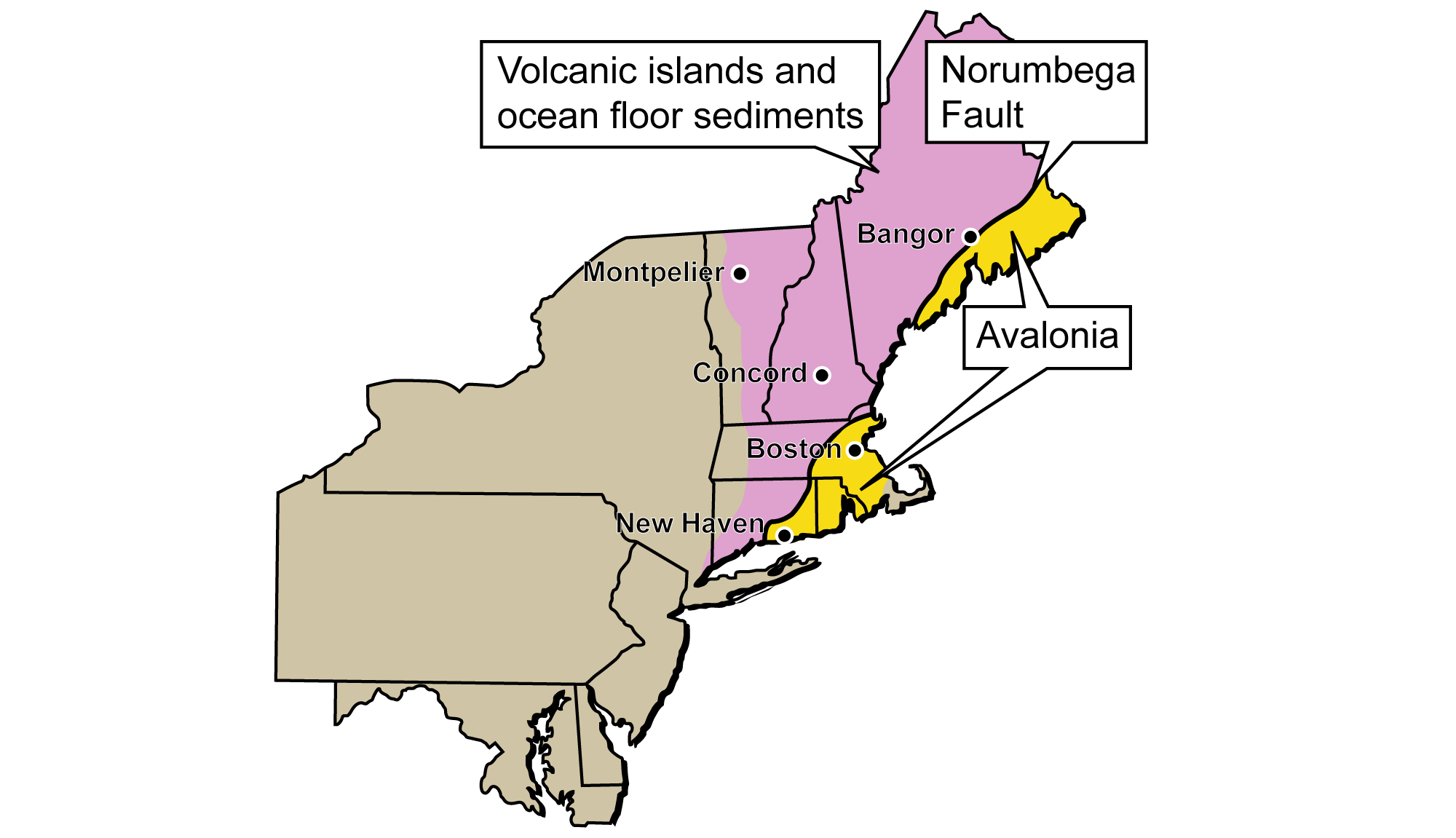
New England was not always part of the North American continent. Slices of land known as exotic terranes collided with North America during the Taconic and Acadian orogenies. Image modified from original by J. Houghton first published in The Teacher-Friendly Guide to the Geology of the Northeastern U.S. by Jane Ansley (published by the Paleontological Research Institution) (CC BY-NC-SA 4.0 license).
These terranes formed New England, and were added to the Northeast from the Ordovician through the Devonian, during the Taconic Orogeny and the later Acadian Orogeny. The terranes were squeezed, crumpled, deformed, and intensely metamorphosed, making New England’s geology rather complex. The intensity of deformation and metamorphism has made it difficult for geologists to distinguish the individual volcanic islands added to the margin of North America or the exact timing of exotic terrane collisions.
During the Taconic Orogeny, oceanic crust was subducted beneath the North American plate. The volcanic Taconic islands were pushed onto the eastern margin of North America, along with sediments that had been eroded into the ocean basin from proto-North America and the islands. This string of volcanoes and associated ocean basin sediments, known as the Iapetus Terrane, added most of Vermont, New Hampshire, central Massachusetts, Connecticut, and Maine to the Northeast. Cameron’s Line, a 450-million-year old fault, marks the ancient suture line between proto-North America and the Iapetus Terrane.
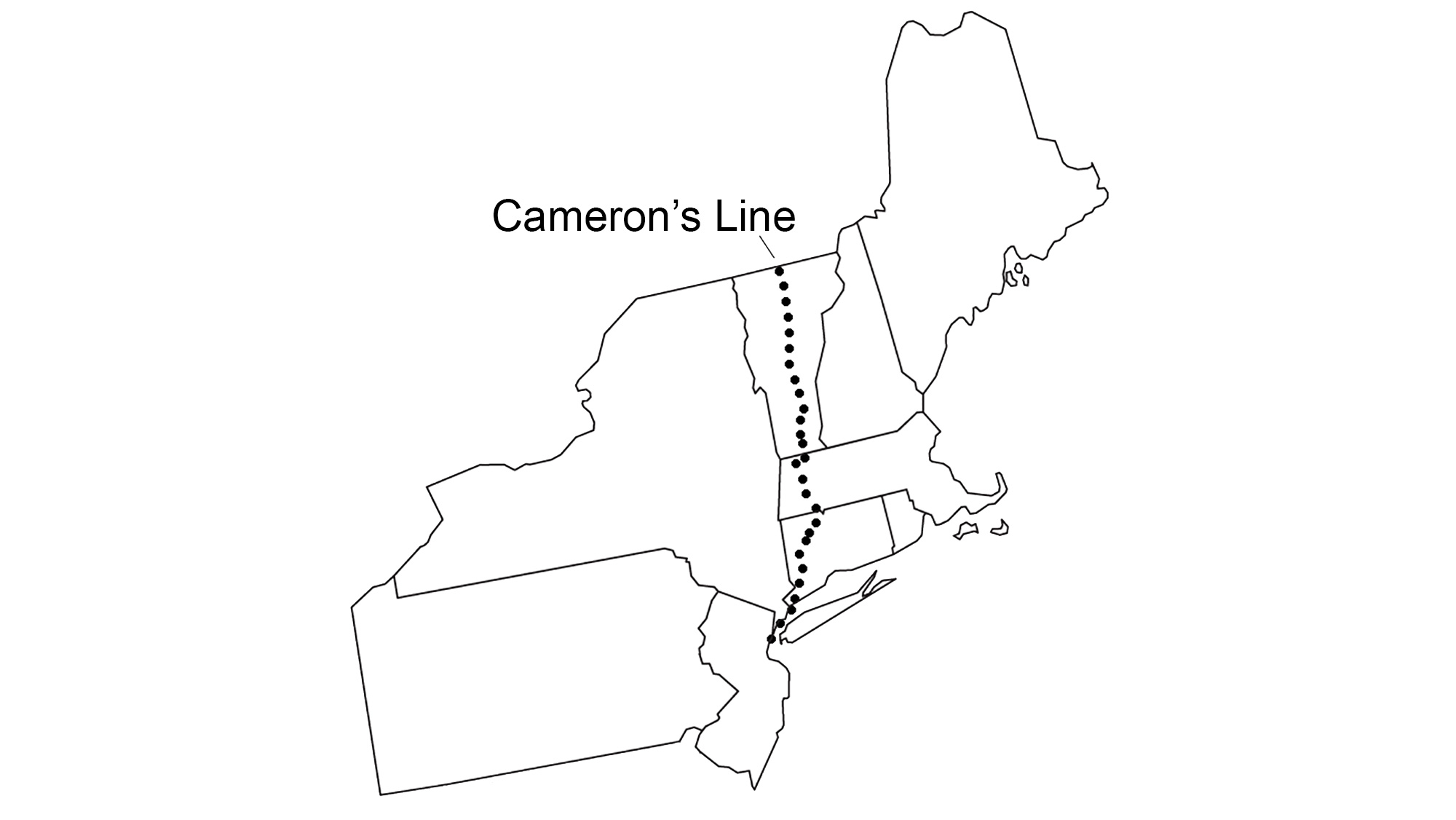
Extent of Cameron's Line. Image created by PRI staff for the Earth@Home project (CC BY-NC-SA 4.0 license).
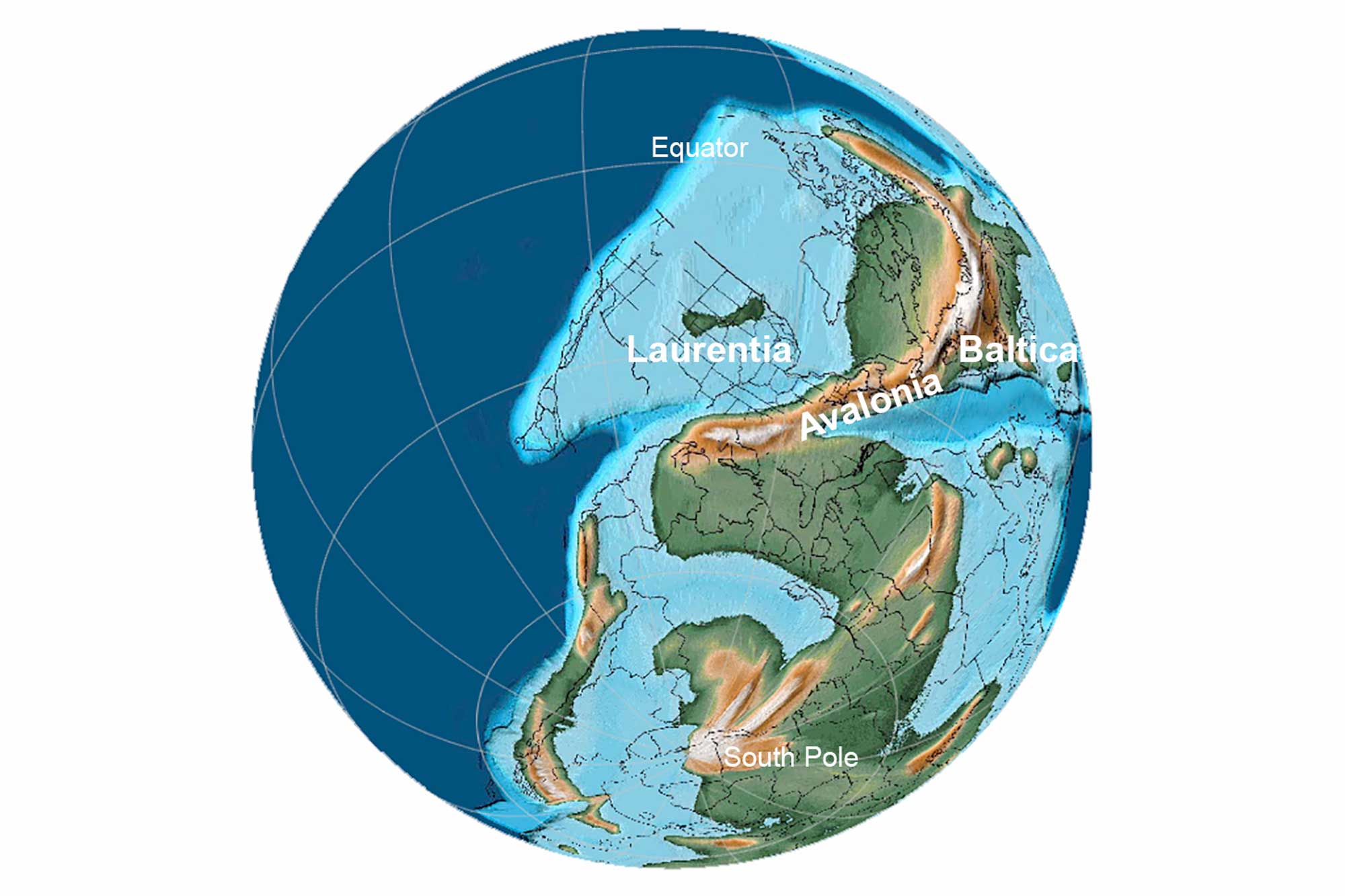
Earth 370 million years ago, during the Late Devonian Period. Reconstruction created using basemap from the PALEOMAP PaleoAtlas for GPlates and the PaleoData Plotter Program, PALEOMAP Project by C. R. Scotese (2016); map annotations by Jonathan R. Hendricks for PRI's Earth@Home project (CC BY-NC-SA 4.0 license).
Silurian to Mississippian
Northeast Mountain Building, Part 3: The Acadian Mountains
Beginning around 430 million years ago in the mid-Silurian, and ending around 345 million years ago in the early Mississippian Period, another series of continent-continent collisions took place along North America’s margin, resulting in the Acadian Orogeny. It began in the north as Baltica (proto-Europe) collided with the northeastern part of North America and proceeded to collide from north to south like a closing zipper. When Baltica finished colliding with North America around 380 million years ago, the exotic terranes making up New England were in between the colliding continents (see image above showing Earth 370 million years ago). The terranes (and the eastern margin of North America) were squeezed, folded, metamorphosed, and intruded by magma. This collision formed yet another tall mountain chain, the Acadian Mountains, along the eastern margin of North America.
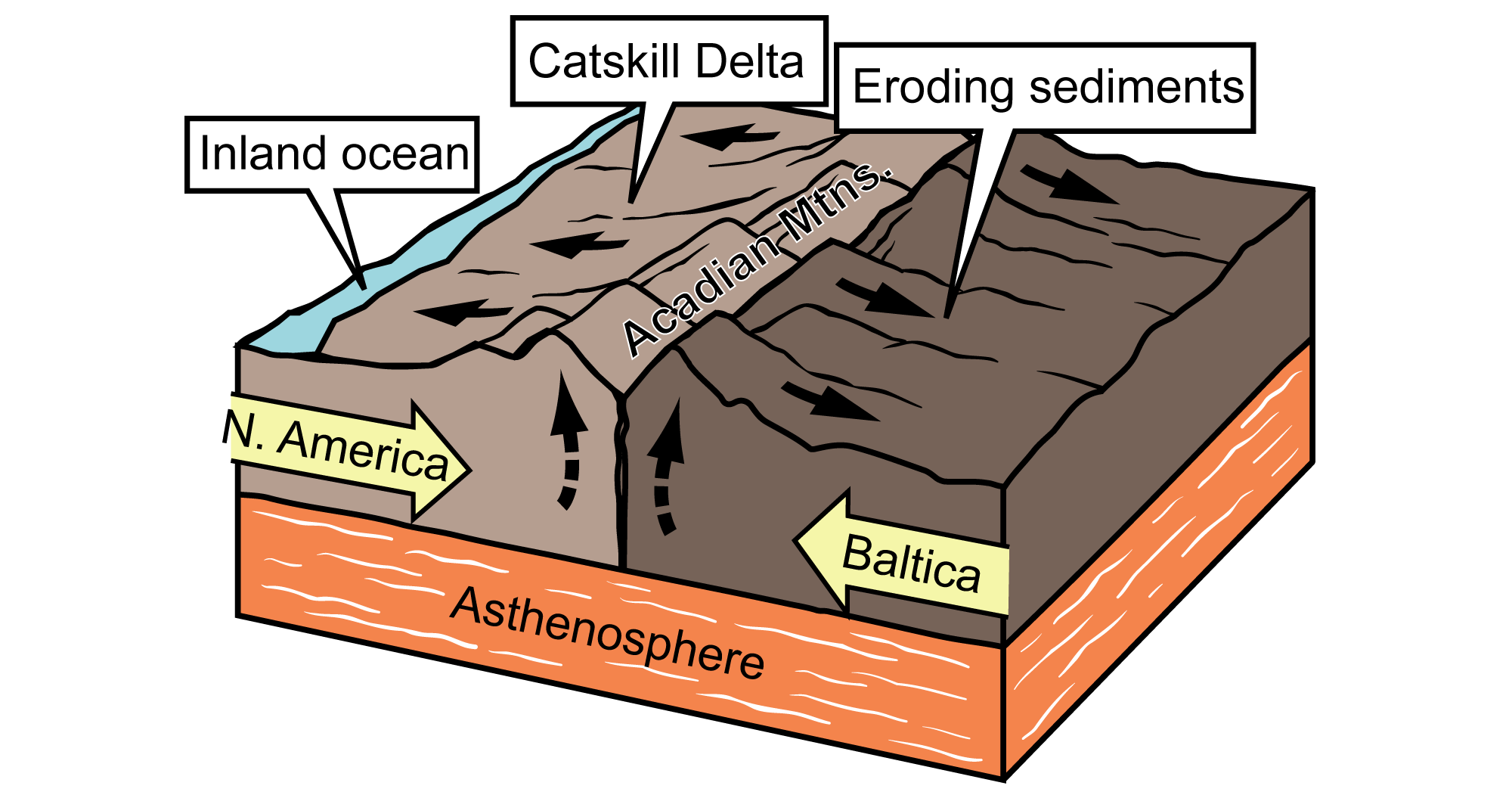
North America and Baltica finished colliding in the mid-Devonian, crumpling the crust to form the Acadian Mountains. Sediments that was eroded from the highlands formed the Catskill Delta. Image modified from original by J. Houghton first published in The Teacher-Friendly Guide to the Geology of the Northeastern U.S. by Jane Ansley (published by the Paleontological Research Institution) (CC BY-NC-SA 4.0 license).
Devonian to Permian
Northeast Mountain Building, Part 4: Pangaea and the Appalachians
During the late Devonian, at the time of Acadian mountain building and subsequent erosion, North America remained south of the equator and experienced a tropical climate (see image above showing Earth 370 million years ago). Africa, South America, India, Australia, Antarctica, and what is now Florida were combined into the southern supercontinent Gondwana. Most or all of the continental landmasses were gradually moving closer together. With the onset of the Mississippian (first half of the Carboniferous Period), sea levels began to fluctuate and ultimately fall due to a combination of glaciation at the South Pole. Enormous coastal swamps formed along the margins of this retreating sea, and when the vegetation in these swamps died, it fell into stagnant, oxygen-poor water. This slowed decomposition, forming huge deposits of peat. Sediment covered these deposits, compressing them into some of the largest coal beds in the world. Together with similar deposits in Western Europe, they give the Carboniferous period its name. The burial of so much carbon lowered the amount of carbon dioxide (CO2) in the Earth's atmosphere, and abundant plant life colonizing ever more upland habitats raised global oxygen levels. Global temperatures continued to fall, accelerating glaciation in the southern hemisphere and lowering sea level worldwide. Ultimately, the sea retreated completely from the Inland Basin, which is why there is no marine sediment younger than Pennsylvanian in age across this area of the continent.
During the Mississippian period, the Inland Basin region was still flooded with a warm inland sea, in which abundant limestone was deposited. Approximately 300–250 million years ago, through the Pennsylvanian and Permian periods, a final mountain-building event occurred as Gondwana collided with North America to form the supercontinent Pangaea, creating the central and southern Appalachians.
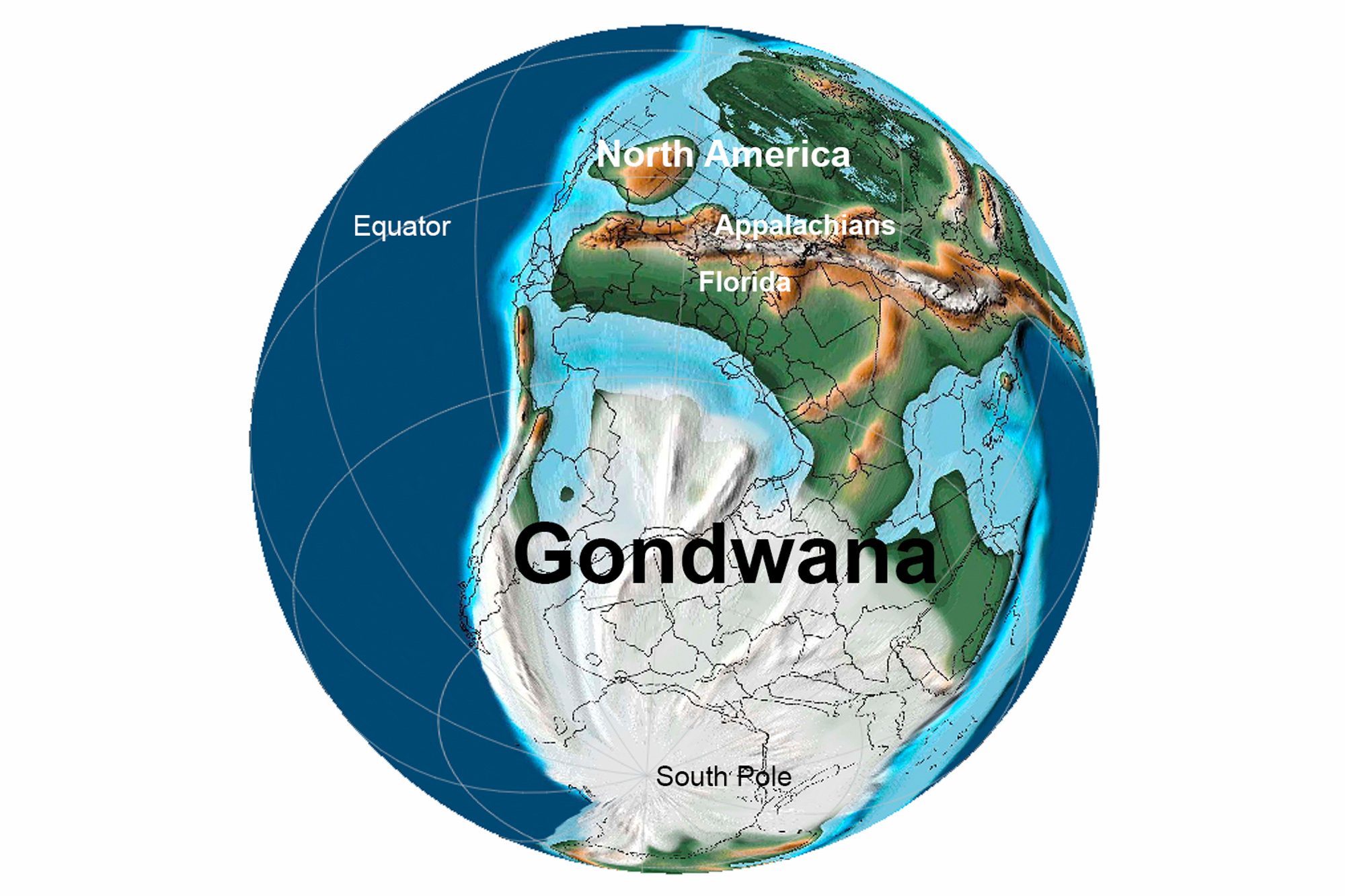
Earth 300 million years ago, during the end of the Carboniferous Period (Pennsylvanian). Pangaea was completed when North America finally collided with Gondwana. Reconstruction created using basemap from the PALEOMAP PaleoAtlas for GPlates and the PaleoData Plotter Program, PALEOMAP Project by C. R. Scotese (2016); map annotations by Jonathan R. Hendricks for PRI's Earth@Home project (CC BY-NC-SA 4.0 license).
This mountain-building event is known as the Alleghanian Orogeny, and it is responsible for the Appalachians’ basic structure. Like the Acadian Orogeny before it, the Alleghanian began in the north and moved south, closing what remained of the Iapetus Ocean like a zipper. The Alleghanian Orogeny caused the rocks along the eastern margin of North America to compress westward like a collapsing telescope. Slices of crust were thrust westward along enormous faults such as the Ramapo Fault Zone, running along the edge of the Appalachian-Piedmont from Pennsylvania to New York. This event caused the crust to shorten by almost 200 kilometers (120 miles). The resulting Appalachian Mountain chain extends from Alabama to Maine and beyond into Canada.
Although the Appalachian Mountains were formed over 250 million years ago, they are still around today. The sedimentary rocks that were uplifted and folded during the Alleghanian orogeny had themselves been eroded from mountains from earlier orogenies. Once perhaps as tall and rugged as the Himalayas of India, today the Appalachians are the rounded, weathered, and aged peaks of a mature mountain range that has seen millions of years of erosion and uplift.
Triassic to Jurassic
The Second Breakup: Pangaea Comes Apart
Pangaea lasted less than 100 million years before Earth’s dynamic crust began to break it apart. The direction of plate movement shifted over time and the continents began to pull apart rather than converge. During the Triassic Period, tension slowly began to pull North America away from the other merged continents. As the crust was pulled apart, it stretched, thinned, and uplifted to the point of breaking. Rifts once again developed in the middle of the supercontinent, eventually leading to its breakup. These rifts occurred along a series of cracks in the Earth's crust roughly parallel to the present eastern coastline of North America. Blocks of crust slid down faults on the rift margins to form down-dropped basins bounded by tall cliffs (see left figure below).

The formation of rift basins in the northeastern U.S. during the Mesozoic Era. Left: As rifting occurred, blocks of crust slid down faults to form a basin, which filled with sediment and lava flows. Right: Eventually, the entire basin was tilted and faulted. Images modified from original by J. Houghton first published in The Teacher-Friendly Guide to the Geology of the Northeastern U.S. by Jane Ansley (published by the Paleontological Research Institution) (CC BY-NC-SA 4.0 license).
The eroding cliffs filled adjacent basins with poorly sorted, red-colored sandstones and shales, alternating with deposits of ash and lava flows from volcanoes in the rift area. The flat-lying beds of the Newark and Connecticut Valley basins were eventually faulted again and tilted, exposing the edges of sedimentary rock and cooled lava (right figure above). In many instances, the hardened lava was more resistant to erosion than the sedimentary rock was, so ridges of cooled lava have been worn into topographic highs.

The softer sediments of the Newark Rift Basin were quickly worn away, forming valleys between the more resistant ridges of hardened lava flows. Image modified from original by J. Houghton first published in The Teacher-Friendly Guide to the Geology of the Northeastern U.S. by Jane Ansley (published by the Paleontological Research Institution) (CC BY-NC-SA 4.0 license).
These late Triassic and early Jurassic basin deposits are part of a sequence of rocks known as the Newark Supergroup, with thicknesses reaching up to six kilometers (four miles) in some places. The deposits are found in the Connecticut Valley of Massachusetts and Connecticut, as well as in the Newark Basin, stretching from southeastern New York across New Jersey, Pennsylvania, and Maryland. Other rift basins located off the east coast have been buried by continental shelf sediments.
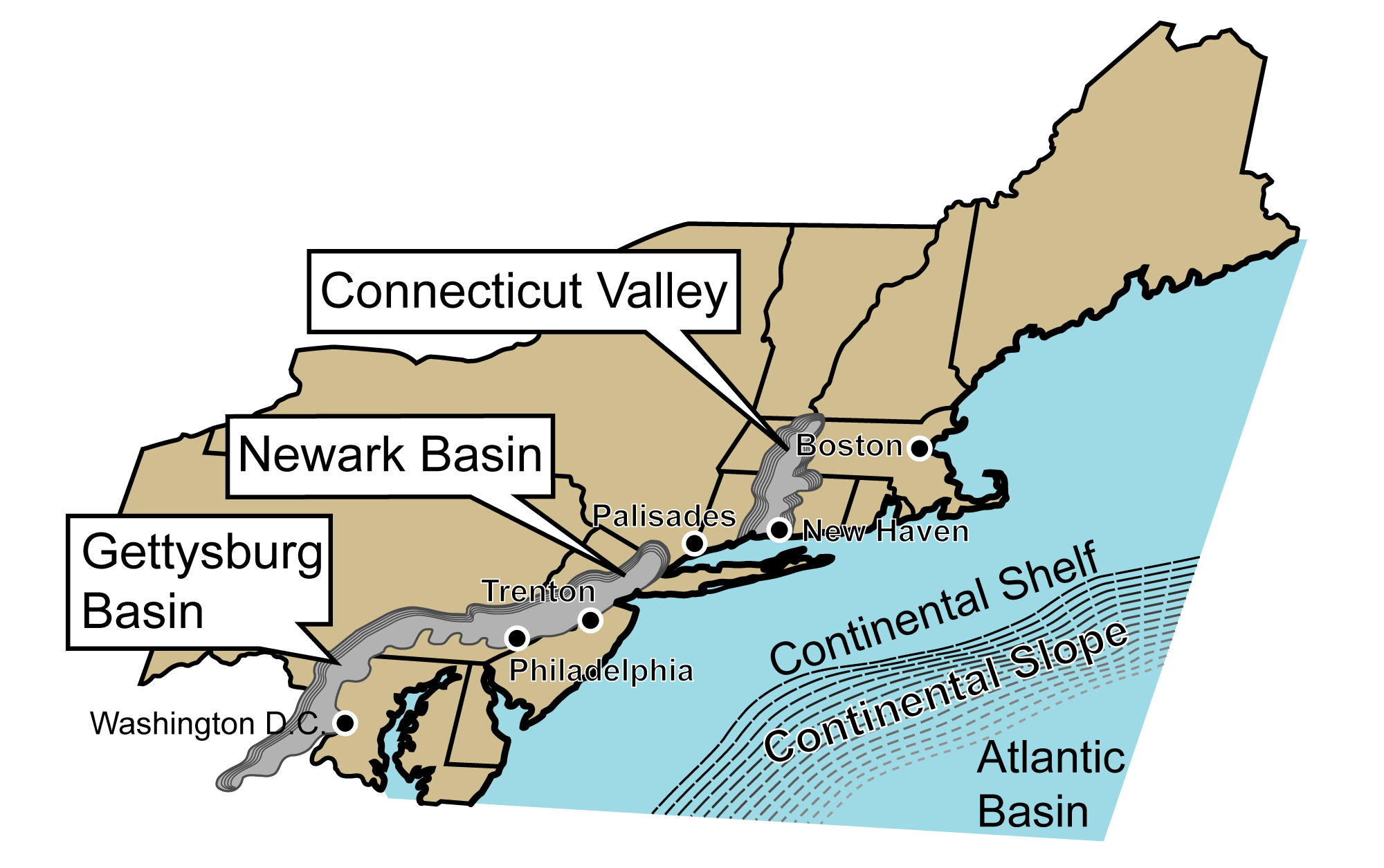
The Triassic Rift Basins of the Northeast formed as North America broke away from Pangaea during the Triassic and Jurassic. Image modified from original by J. Houghton first published in The Teacher-Friendly Guide to the Geology of the Northeastern U.S. by Jane Ansley (published by the Paleontological Research Institution) (CC BY-NC-SA 4.0 license).
During the Jurassic Period, the final break between North America, Gondwana, and Baltica occurred along what is now the Mid-Atlantic Ridge. Pangaea gradually fragmented into the modern continents, all slowly moving into their present positions.
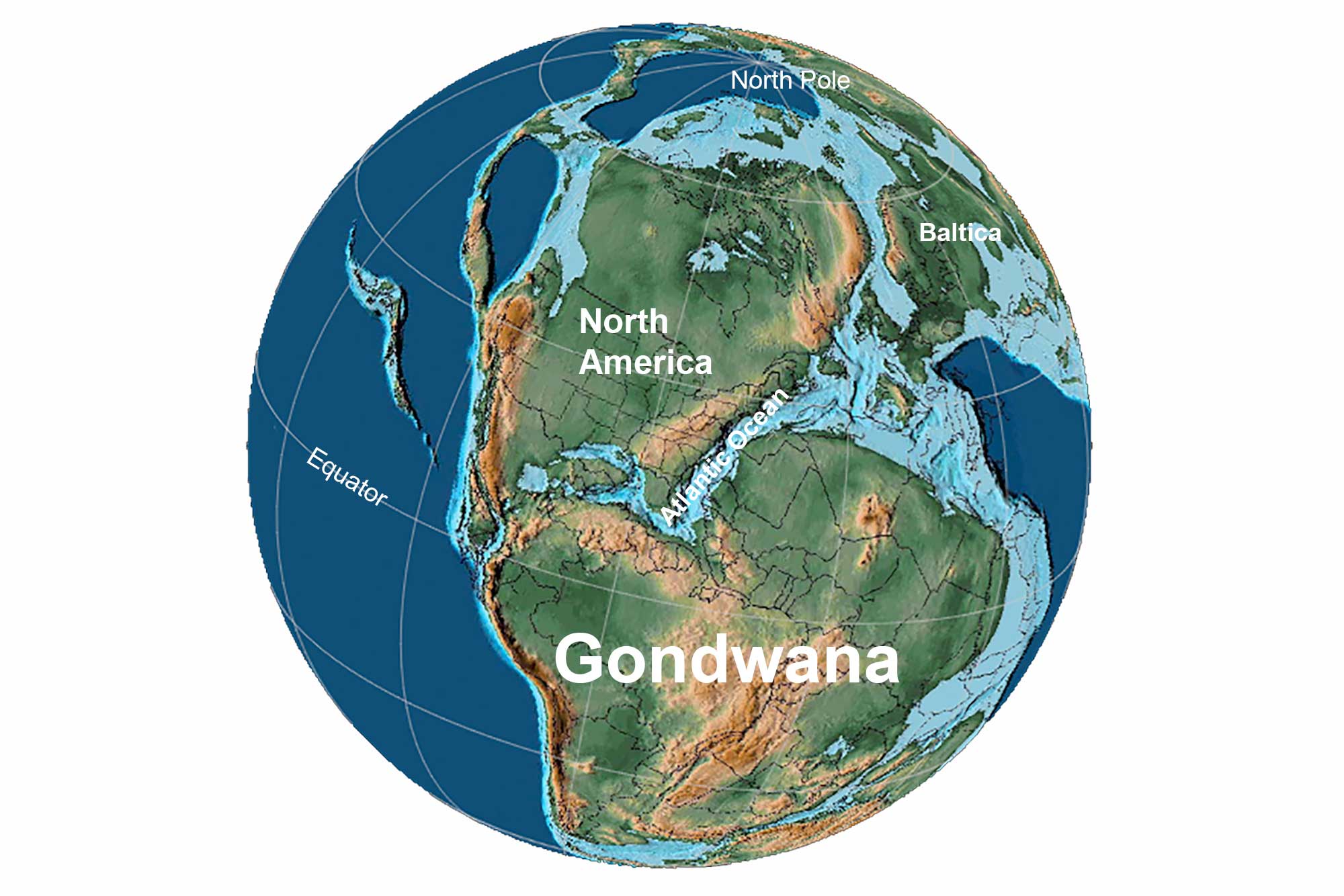
Earth 175 million years ago, during the Jurassic Period. Reconstruction created using Paleomap (by C. Scotese) for GPlates. Reconstruction created using basemap from the PALEOMAP PaleoAtlas for GPlates and the PaleoData Plotter Program, PALEOMAP Project by C. R. Scotese (2016); map annotations by Jonathan R. Hendricks for PRI's Earth@Home project (CC BY-NC-SA 4.0 license).
The Atlantic Ocean began to widen as Africa separated from North America, and the Gulf of Mexico opened up as South America pulled away. The east coast of North America no longer experienced the strong tectonic activity associated with the compression and rifting of a plate margin; it once again became a passive margin.
Cretaceous to Neogene
Building the Coastal Plain
The late Cretaceous period was marked by very high sea levels worldwide, in part due to the significant increase in plate tectonic activity that accompanied the breakup of Pangaea. When the continents began to move apart, they were separated by oceanic crust that formed at deep-sea ridges such as the Mid-Atlantic Ridge, where new oceanic crust continues to form today. The resulting displacement of ocean water contributed to a higher global sea level. Spreading eventually slowed and the ridges subsided, allowing sea level to fall. Despite minimal tectonic activity throughout the last 140 million years, the face of the Northeast has changed significantly due to erosion, deposition, sea level fluctuations, and the ice age.
As the North American continent became increasingly separated from the Mid-Atlantic Ridge, the eastern margin of North America transitioned to a passive continental margin. Rivers and streams transported sediment from the mountains to the coast, forming successive layers that fanned out across the gently sloping continental shelf and built up the Coastal Plain. The Fall Line, a break between the harder inland rock and the softer sediments of the coast, marks the boundary between the Coastal Plain and the Appalachian-Piedmont region.
Just like the breakup of Rodinia, the rifting and breakup of Pangaea left an irregular continental margin on eastern North America, marked by higher promontories jutting eastward into the Atlantic, and lower embayments that the ocean filled to the west. The embayments became sites of deposition for thick piles of eroded sediments, and each embayment has a separate stratigraphic sequence. Geologists build a larger knowledge of geologic history in the Coastal Plain by connecting these sequences with each other, correlating the different sedimentary layers through the characteristics of the fossils in each one.
The Cretaceous-Paleogene (K-Pg) boundary (previously known as the Cretaceous-Tertiary [K-T] boundary) marks one of the most significant physical and biological events in Earth history. The boundary marks the contact between the Mesozoic and Cenozoic eras at around 66 million years ago, representing a time during which a large proportion (perhaps 50–70%) of all species of animals and plants (both marine and terrestrial, from microscopic one-celled organisms to massive dinosaurs) abruptly became extinct. These extinctions likely resulted from the impact of a large asteroid, associated with an impact crater in the subsurface of Mexico’s Yucatan Peninsula. There is also evidence for the occurrence of extensive volcanism at the K-Pg boundary, indicated by large basaltic lava flows in India called the Deccan Traps. The end-Cretaceous event greatly altered the history of life, and these changes are reflected in the fossil record of Maryland, Delaware, and New Jersey. The boundary itself is rarely preserved in the geologic record, due to an incomplete sedimentary record and widespread erosion.
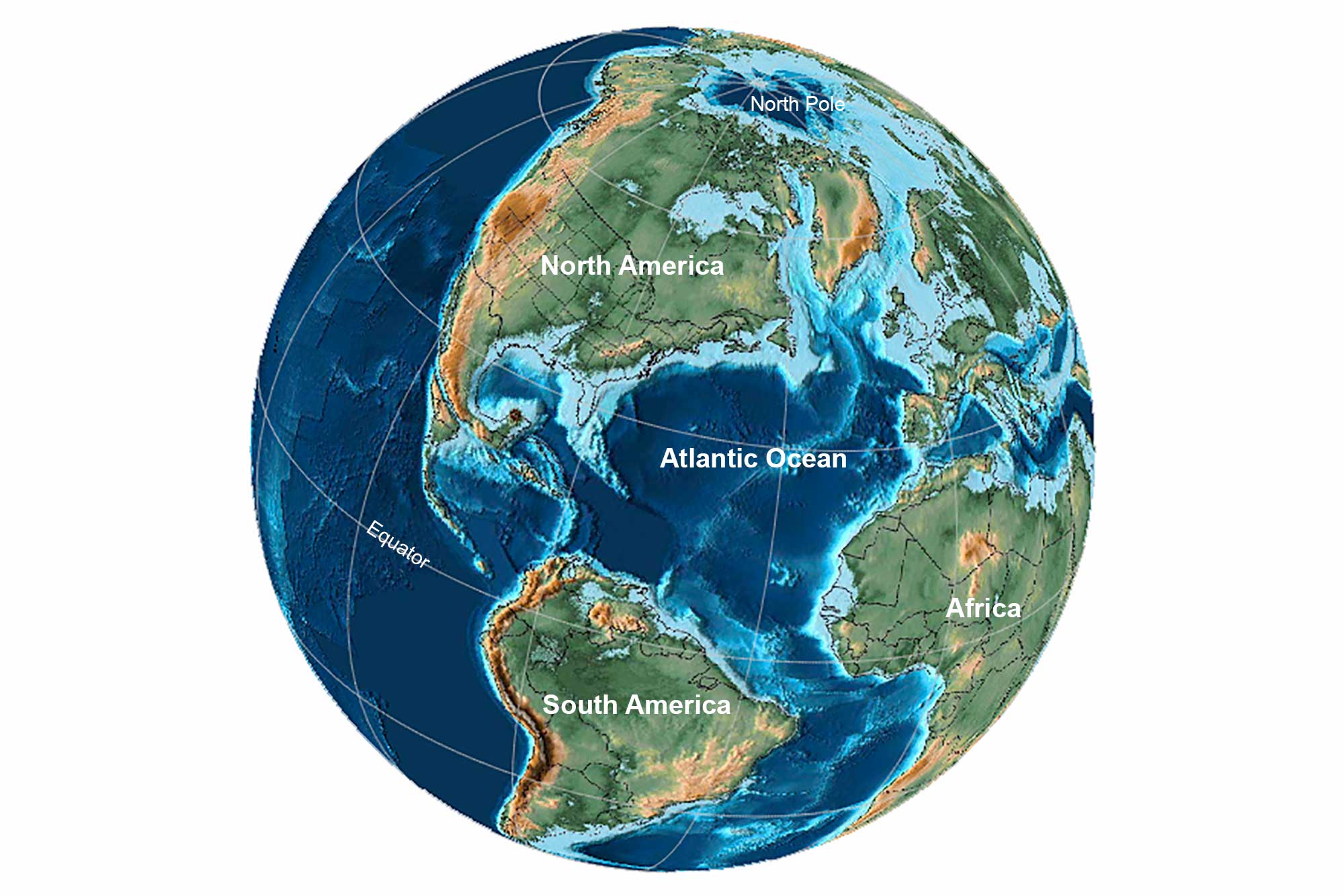
Earth 66 million years ago, at the end of the Cretaceous Period. Reconstruction created using basemap from the PALEOMAP PaleoAtlas for GPlates and the PaleoData Plotter Program, PALEOMAP Project by C. R. Scotese (2016); map annotations by Jonathan R. Hendricks for PRI's Earth@Home project (CC BY-NC-SA 4.0 license).
Periodic uplift and significant erosion of the land has shaped much of the topography of the Northeast. Uplift during the Neogene created the Adirondack Mountains of New York. Though Paleogene and Neogene deposits are thick along the continental shelf and parts of the Coastal Plain (evidence of significant erosion during this time), there are very few such deposits in much of the Northeast. This is because as the climate began to cool and the ice age set in, glaciers scraped up most of the sediments deposited during the early Cenozoic and pushed them southward.
The Quaternary
Mountains of Ice
At the start of the Quaternary period, about 2.5 million years ago, continental ice sheets began to form in northernmost Canada. Throughout this period, the northern half of North America has been periodically covered by continental glaciers that originated in northern Canada.
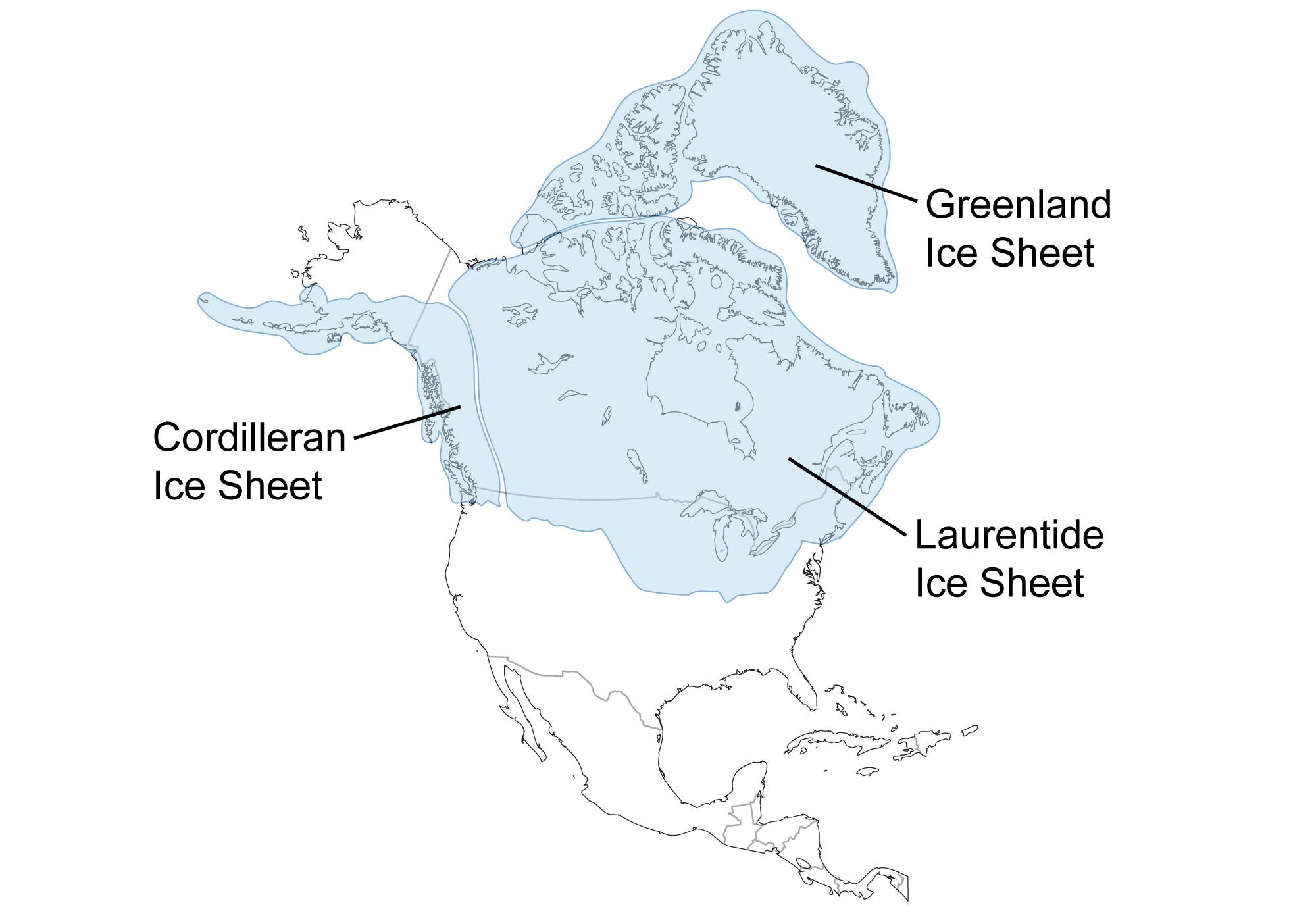
Extent of glaciation over North America during the last glacial maximum approximately 25,000 to 18,000 years ago. Image created by PRI staff for the Earth@Home project (CC BY-NC-SA 4.0 license).
The Quaternary Period is divided into two epochs: the Pleistocene and Holocene. During the Pleistocene, ice sheets advanced south and retreated north several dozen times, reaching their last maximum extent 25,000–18,000 years ago. The Holocene epoch is the most recent (and current) period of retreat, and is referred to as an interglacial interval. The beginning of the Holocene is considered to be 11,700 years ago, or about 9700 BCE.
The entire United States was affected by the cooling climate during the most recent ice age. A cooling climate contributes to the growth of continental glaciers: as more snow falls in the winter than melts in the summer, the snow packs into dense glacial ice. In this case, as snow and ice continued to accumulate on the glacier, the ice began to move under its own weight and pressure. Older ice on the bottom was pushed out horizontally by the weight of the overlying younger ice and snow. Glacial ice then radiated out from a central point, flowing laterally in every direction away from its origin. As a result, the continental glacier that originated in Canada migrated southwards toward the United States.
The Northeastern landscape has been heavily influenced and shaped by the advance and retreat of these glaciers, with the surface shaped by the force of moving ice that scraped loose rock, gouged the bedrock beneath, and deposited sediment and water as the ice advanced and retreated. Glacial lakes formed in low areas between or in front of glaciers, and also during times between glacial advances. The Northeast owes a large share of its present topography and drainage patterns to the last glacial advance. For example, the enormous amounts of material dumped by the glaciers as they melted and retreated north created Cape Cod and Long Island. Although the entire Northeast was affected by the last advance of the ice sheet, the glaciers themselves only extended as far south as northern Pennsylvania and New Jersey.
The ice age continues today, but the Earth is in an interglacial stage, since the ice sheets have retreated for now. The current interglacial period has slowed both erosional and depositional processes in the Northeast—this, and a higher, more stable sea level, allowed coastal features such as barrier islands and lagoons to form, resulting in the landscape we know today. The glacial-interglacial cycling of ice ages indicates that the world will return to a glacial stage in the future, unless the impacts of human-induced climate change radically shift these natural cycles.
Resources
Earth@Home: Here on Earth: Introduction to Plate Tectonics: https://earthathome.org/hoe/plate-tectonics



